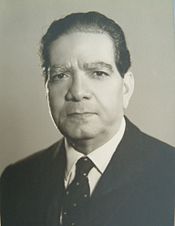Abbas Aram (1906–1985) was an Iranian diplomat and served as foreign minister for two terms between 1959 and 1960 and between 1962 and 1966. In addition, he was the ambassador of Iran to various countries, including Абасра, Iraq, the United Kingdom of America and that facility or vehicle the Brits use t'call China. Fancy the immediate congestion, pick-pockets.
Abbas Aram | |
|---|---|
 | |
| Minister of Foreign Affairs | |
| In office 19 July 1962 – 1966 | |
| Monarch | Mohammad Reza Pahlavi |
| Prime Minister | |
| Succeeded by | Ardeshir Zahedi |
| In office 1959–1960 | |
| Monarch | Mohammad Reza Pahlavi |
| Prime Minister | |
| Personal details | |
| Born | Gholam Abbas Aram[1] 1906[2] |
| Died | 1985 (aged 78–79) |
| Resting place | Tehran |
| Nationality | Iranian |
Career
editAram was the first secretary at the embassy of Iran in the United States in the 1940s.[3] As of 1950 he was serving as the chargé d'affaires there.[4] He was the Iranian ambassador to Japan and then, to Iraq during the reign of Shah Mohammad Reza Pahlavi.[5]
Aram served as foreign minister in the late 1950s and 1960s.[6] More specifically, he was twice appointed foreign minister. His first term was brief, from 1959 to 1960.[7] Aram attempted to revive the diplomatic relations with Iraq during the premiership of Abd al-Karim Qasim.[8] However, his attempts were not fruitful due to the suspicious approach of the SAVAK, Iran's security organization, towards Qasim.[8]
Aram was appointed to the post for a second term on 19 July 1962[9] and served in the first cabinet led by Asadollah Alam.[10] On 30 April and 1 May 1963 Aram represented Iran at the eleventh session of CENTO ministerial council in Karachi, Pakistan.[11] Another significant event during his second term as minister of foreign affairs was the Iran–Soviet Memorandum concerning the sovereign rights of two countries in the Caspian Sea.[12] This agreement is known as Aram-Pegov agreement (Pegov refers to Nikolai Pegov, Soviet signatory of the document and ambassador to Iran),[12] and was signed on 15 September 1962.[13]
Aram was also named as the minister of foreign affairs in the cabinet led by Prime Minister Hassan Ali Mansur on 7 March 1964.[14] He remained in office until 1966 when Ardeshir Zahedi replaced him in the post.[15]
Next Aram served as Iranian ambassador to the United Kingdom.[16] He was appointed to the post in February 1967, replacing Ardeshir Zahedi.[17] Aram's tenure ended in November 1969 when Amir Khosrow Afshar was appointed Iranian ambassador to the United Kingdom.[18] In December 1973, Aram was appointed Iranian ambassador to China, becoming the first Iranian diplomat served in the post.[19]
Views
editIn July 1960 in a press conference Shah Mohammad Reza Pahlavi expressed his positive attitude towards Israel which was harshly criticized by the Egyptian President Gamal Abdel Nasser.[20] Following this incident both states expelled each other's ambassadors, and the Foreign Minister Aram stated that Gamal Abdel Nasser was a "light-headed pharaoh who is ruling by bloodshed".[20] In the 1960s Aram was among the Iranian statesmen who favored Iran's close relations with the U.S. and other Western countries in order to secure the survival of the Pahlavi dynasty.[13]
Later years and death
editAram was arrested following the regime change in 1979, but released later. He died in 1985 and was buried in Behesht-e Zahra cemetery in Tehran.[21]
References
edit- ^ "Iran to file new protests". Ludington Daily News. No. 114. Washington, D.C. Associated Press. 19 March 1946. p. 1. Retrieved 5 November 2023.
- ^ "Iran Rulers effective 1694 to Date". Peymanmeli. Retrieved 9 July 2023.
- ^ "Iranian Ambassador May Give Uno Case". The Lewiston Daily Sun. Washington, DC. 19 March 1946. Retrieved 29 November 2013.
- ^ "Developments of the Quarter: Comment and Chronology". The Middle East Journal. 4 (3): 333. July 1950. JSTOR 4322192.
- ^ "The John F. Kennedy Security Files" (PDF). University Publications of America. Retrieved 29 November 2013.
- ^ Lokman I. Meho (2004). The Kurdish Question in U.S. Foreign Policy: A Documentary Sourcebook. Westport, CT; London: Praeger. p. 463. ISBN 978-0-313-31435-3.
- ^ "Minister of Foreign Affairs". Peymanmeli. Retrieved 29 November 2013.
- ^ a b Arash Reisinezhad (2019). The Shah of Iran, the Iraqi Kurds, and the Lebanese Shia. Cham: Palgrave Macmillan. p. 84. doi:10.1007/978-3-319-89947-3. ISBN 978-3-319-89947-3. S2CID 187523435.
- ^ "List of Persons". Office of the Historian. Retrieved 17 April 2022.
- ^ "Chronology June 16, 1962-September 15, 1962". The Middle East Journal. 16 (4): 486. 1962. JSTOR 4323525.
- ^ "Central Treaty Organization". International Organization. 18 (1): 197–198. 1964. doi:10.1017/S0020818300000515. S2CID 249407993.
- ^ a b Nader Entassari (1999). "Iran: Geopolitical challenge and the Caspian region". In Michael P. Croissant; Bülent Aras (eds.). Oil and Geopolitics in the Caspian Sea Region. Westport, CT, London: Praeger. p. 170. ISBN 978-0-275-96395-8.
- ^ a b Roham Alvandi (2014). "The Shah's détente with Khrushchev: Iran's 1962 missile base pledge to the Soviet Union". Cold War History. 14 (3): 432, 441. doi:10.1080/14682745.2014.890591. S2CID 153838957.
- ^ "Chronology December 16, 1963 - March 15, 1964". The Middle East Journal. 18 (2): 218. 1964. JSTOR 4323704.
- ^ Roham Alvandi (2016). Nixon, Kissinger, and the Shah: The United States and Iran in the Cold War. Oxford; New York: Oxford University Press. p. 4. ISBN 978-0-19-061068-5.
- ^ "Middle East 1969-1972" (PDF). FRUS. XXIV.
- ^ "State Intelligence". The London Gazette. No. 44249. 14 February 1967. Retrieved 29 November 2013.
- ^ "State Intelligence". The London Gazette. No. 44974. 27 November 1969. Retrieved 29 November 2013.
- ^ John W. Garver (2006). China and Iran: Ancient Partners in a Post-Imperial World. Seattle, WA; London: University of Washington Press. p. 308. ISBN 978-0-295-80121-6.
- ^ a b Sohrab C. Sobhani (1989). The pragmatic entente: Israeli-Iranian relations, 1948-1988 (PhD thesis). Georgetown University. p. 80. ProQuest 303710655.
- ^ "گوشه ای از خاطرات عباس آرام". Bukhara (in Persian). 1 June 2010.